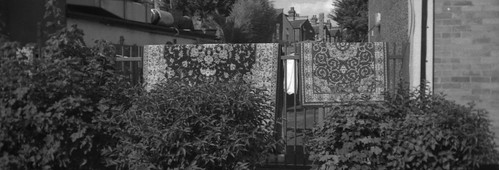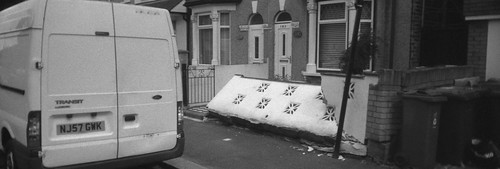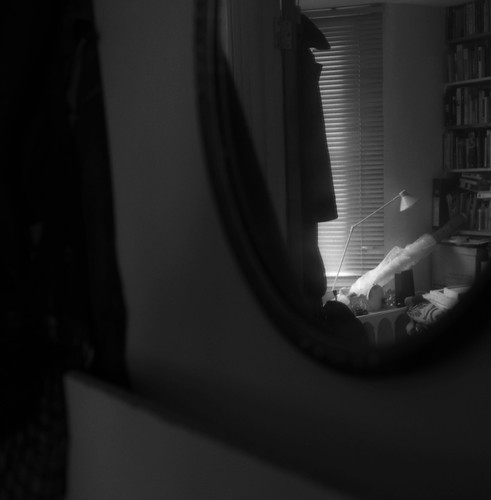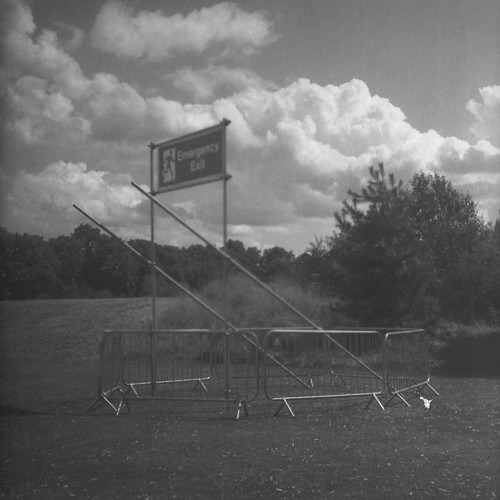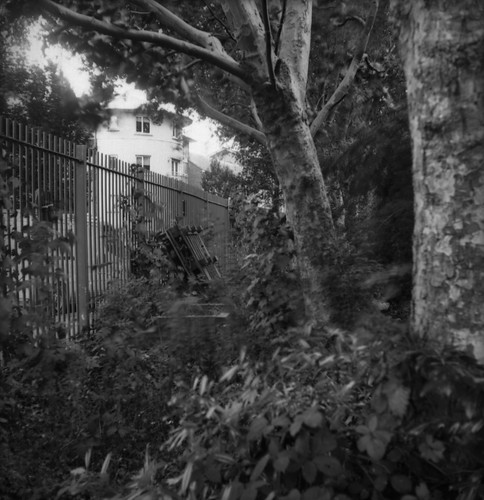 |
| Rolleiflex 4x4 |
From the Rolleiflex 6x6, which from the beginning set the pattern for the development of the twin-lens reflex camera, the Rolleiflex 4x4 has taken the basic principles of its construction.
Rolleiflex 4x4 manual
On top of being given old cameras, with something of a reputation for them, occasionally I am lent them: one such borrowed camera I have been testing recently is the
Rolleiflex 4x4, a 127 rollfilm format twin-lens reflex camera from the 1950s. The camera still has its original dual-lens cap and strap, missing its clam-shell ever-ready case, and has clearly been well used, the grey leather panels wearing down to its natural colour. Inside the camera back is a dealer decal reading 'Foto-Krischker Tirschenreuth', Tirschenreuth being a small town in Bavaria close to the Czech border.
The Rollei Club website has a
detailed page on the evolution of the Rolleiflex 4x4. The initial version of the camera was introduced in 1931, combining the innovations of the larger original Rolleiflex with the increasing popularity of smaller format cameras such as the Leica, amongst others, and developed through the 1930s to the early 1940s - and then brought back in 1957 with the distinctive grey leather inset panels and painted metal trim. The 'Grey Baby' or 'Baby Grey' Rolleiflex inspired a number of Japanese-made 127-format twin-lens cameras such as the
Yashica 44,
Primo Jr, and the
Waltz Automat 44, often in grey. The grey version of the Rolleiflex 4x4 had a much larger production run than any previous model, over 60,000; it was superseded by a final black version with the same specifications from 1963, in much smaller numbers - less than 5,000, and finally discontinued in 1968. All versions of the camera were simply called Rolleiflex 4x4 by Franke & Heidecke/Rollei, but with codes for internal use: the final camera, whether grey or black, is the K5 model. However, the Rolleiflex 4x4 is colloquially and commonly known as the 'Baby' Rolleiflex, although never officially named as such; by contrast Zeiss Ikon adopted the 'Baby' prefix for their 127 cameras based on larger original versions, such as the
Baby Box Tengor. Perhaps, unlike Zeiss Ikon - catering for all pockets - aiming at a wealthier customer Rollei disdained the colloquialism of the word 'Baby'.
 |
| Rolleiflex 4x4 |
The Rolleiflex 4x4 cameras are as well designed and constructed as the larger 120 cameras, and with similar specifications. Pre-war Rolleiflex 4x4s all had Tessar lenses; the post-war model features a Schneider-Kreuznach Xenar f3.5 lens with a focal length of 60mm (the serial number of this particular camera's lens dates it to 1958, fairly early in production); the viewing lens is a faster Rollei Heidosmat f2.8. The lens will focus down to 1 metre, and the focus knob has a depth of field scale around it and includes a film speed reminder for ASA and DIN. The shutter is a Synchro-Compur with speeds from 1-500, plus B. There is flash sync with a PC socket and a switch for electronic flash or flash bulbs which also has 'V' for the self timer. There is a small button underneath the shutter surround to change this switch. The threaded shutter release is angled upwards and slightly out from the body under the taking lens.
One feature of the Grey Baby Rolleflex 4x4 which firmly locates it as a 1950s-designed camera is its coupled LV (Light Value) system. Aperture and shutter speeds are linked together, so a number of combinations of the two can be selected which will give the same effective exposure. Many cameras during the 1950s and 60s used such systems before this fell out of favour; most contemporary commentators online seem to conceive of the LV shutter-aperture linkage as a solution to a problem that barely exists. On one side of the taking lens the LV numbers run from 2 to 18 with a dot to indicate the selected number; the other side of the shutter has the aperture and shutter speed settings.
 |
| Rolleiflex 4x4 aperture and shutter speed selectors |
The aperture ring has a raised section with a grip which needs to be depressed to turn this
separately from the shutter speed section in front: on the other side of the shutter this moves the red dot in relation to the LV numbers to select the exposure; it is possible to select intermediate aperture stops.
The back of the camera has a detailed exposure guide, essentially a sophisticated version of the 'sunny 16' rule, with subjects and lighting conditions, which, when correlated with film speed and adjusted for time of day, produce a number to set on the LV scale of the shutter.
 |
| Rolleiflex 4x4 exposure guide |
One final observation about the LV scale worth noting is that the shutter has a series of numbers picked out in green
beyond the 'B' setting, representing whole seconds for calculating long exposures (as the shutter has 1 second as its lowest speed, the 'B' setting actually represents 2 seconds on the LV scale).
 |
| Rolleiflex 4x4 viewfinder |
Opening the lens hood reveals the ground glass screen viewfinder with a subtle grid to aid composition; pushing on the front of the viewfinder hood flips up a magnifier to aid focus; pushing the front through until it locks down converts this into the sports finder. The magnifier can be slipped out to replace this with corrective lenses to compensate for eyesight; pushing in the hinges on either side of the hood collapses the whole. The viewfinder has parallax compensation, though on examining the camera it isn't obvious how this is achieved, but possibly through a subtle movement of the focus screen, not dissimilar to the parallax compensation with the
Rollei 16.
Opening the camera, the base around the tripod mount has a rotating lever, turning anti-clockwise, to push forward the hinged latch which, when flipped, allows the whole bottom and back to be lifted upwards opening the camera to load the film. Film travels from bottom to top in the camera, both spool holders flip out in different ways to enable loading and unloading. The frame counter is entirely automatic, without a red window. Once loaded and closed, the film is advanced until the numeral 1 appears in the counter window and the advance knob stops until the shutter is released; the shutter release is locked when the viewfinder hood is down. Without a film in the camera, the counter shows '0' and the shutter can be cocked by turning the advance knob and released as normal. The pre-war Rolleiflex 4x4 cameras had an advance lever, but the post-war version has a knob instead (many of the Japanese 4x4 TLR cameras did have advance levers however), more like the contemporary Rolleicord cameras, yet the 4x4 retains the Rolleiflex name.
 |
| Rolleiflex 4x4 - back open |
With the back open, two small levers to the right of the film window can be seen. One appears to be a feeler for the film; the second appears to be a lever that, when released by opening the back, resets the film counter. When first testing the camera, the shutter seemed to stick at all speeds; after thinking that this was simply the fact that, after sixty years, the shutter needed to be stripped down and cleaned, I moved the flash sync switch to the bulb position - and the shutter works as accurately as one might expect, even at slow speeds. Evidently the electronic flash sync seems to conflict with the shutter mechanism and as this hasn't turned up in searching for shutter problems, so this might just be an idiosyncratic issue with this particular camera.
 |
| Rolleiflex 4x4 with Ilford HP5 Plus |
With the first roll of film through the camera (a short off-cut of cut-down
Ilford HP5 Plus), the qualities of the Rolleiflex 4x4 are immediately apparent. The 127 rollfilm format - in all its standard frame sizes, 6x4, 4x4, and 3x4 - provides larger images than the standard 35mm frame; set against this is the fact that many, if not most, cameras designed around the 127 format tend towards the cheaper end of the consumer market, inevitably not fully taking advantage of the larger negative area. In the image above (which could of course be shot on finer-grained film than HP5 Plus) the sharpness of the Xenar lens is clear despite the nondescript subject matter. The camera sits well in the hand, perhaps easier to operate than larger 120 format camera, supported by the right hand, focus by the left, the shutter release positioned to be operated by the right thumb, and switching support from one hand to other to advance the film simple enough.
 |
| Rolleiflex 4x4 with 35mm Ilford Pan 100 |
As well as medium format film cut down to 127, I also ran a roll of 35mm
Ilford Pan 100 through the camera and found that all the frames were out of focus in the centre; the image above was one of the
more in-focus frames. Having used 35mm rolled with 127 backing paper previously, I was surprised to find this happen with the Rolleiflex, although I have had similar issues when using 120 film with 116 backing paper, as the smaller width of the film is not supported at the sides with the result that film flatness suffers. However, the 116 frame is nearly three times longer than the nominal 4x4 size with the Rollieflex 4x4. Other 127 cameras seem to be better at this, with the
V. P. Twin possibly being the exception, but not consistent. When using the camera with cut-down medium format film and 127 backing paper, the main problem that cropped up was that the first frame did not align correctly with the start of the film, resulting in half an image with the tape visible; this may be down to the film not being taped to exactly the right position on the backing paper.
The Rolleiflex 4x4 is clearly one of the most sophisticated 127 format cameras ever made; some of the Japanese 4x4 TLR cameras do have light meters, the only feature that could be thought of as lacking from the Rolleiflex. This last iteration of the Rolleiflex 4x4, coming at the time that cameras began to feature built-in light meters, was perhaps popular enough at the height of the late 1950s 4x4 twin-lens reflex craze for there to be little impetus to develop the camera any further. As with other Rollei cameras, there is an attention to detail in the construction and manufacture that occasionally feels like over-engineering, but solid enough to inspire confidence and small enough for portability, perhaps able, briefly, to compete with the sophisticated 35mm cameras of their time. As a result, the Rolleiflex 4x4 is still an eminently usable 127 camera, continued access to 127 film notwithstanding.
 |
| Rolleiflex 4x4 with Kodak High Resolution Aerial Duplicating Film |
 |
| Rolleiflex 4x4 with Ilford FP4 Plus |
 |
| Rolleiflex 4x4 with Ilford HP5 Plus |
Sources/further reading:
The Rollei Club on all Rolleiflex 4x4 models
Rolleiflex 4x4 manual (PDF file)
Baby Rolleiflex on onetwoseven.org
The Baby Rolleiflex on Camera-Wiki
Rolleiflex 4x4 on Mike Elek's Classic Cameras
127 film and the Rolleiflex 4x4 Rollei Users' Club
Anthony J. Oresteen - Using the 1957 Rolleiflex 4x4 "Baby" Models










